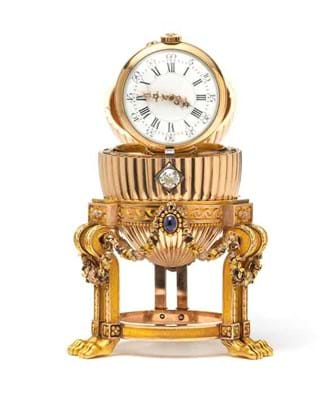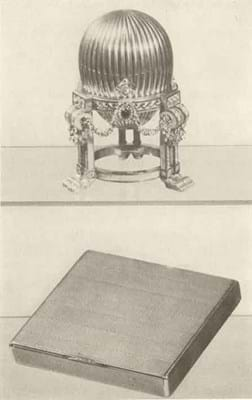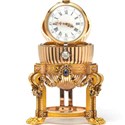After a multi-million pound sale earlier this year, the buyer has agreed the Third Imperial Fabergé Easter Egg, its whereabouts unknown for more than a century, will go on public display in London for four days in the run up to Easter.
Until the rediscovery in near miraculous circumstances, eight of the 50 eggs made to unique designs by Carl Fabergé for the doomed Russian Royal family, were deemed missing with only three of those believed to have survived the Revolution.
This Fabergé egg, a diminutive 3.25in (8.2cm) high and made in yellow gold set with cabochon sapphires and rose diamonds, opens via a brilliant-cut diamond pushpiece to reveal a watch with diamond-set hands by the Swiss maker Vacheron Constantin. Made in the workshop of Fabergé's chief-jeweller August Holmström in St Petersburg, 1886-1887, it was given by Alexander III to the Empress Maria Feodorovna in 1887, making this the third of the Imperial eggs.
It was last seen in public 112 years ago when it was photographed in the Von Dervis Mansion exhibition of the Imperial family's Fabergé collection in St Petersburg in March 1902. It was later confiscated by the Bolsheviks and recorded in a Moscow inventory in 1922 at the time when many Imperial treasures were sold to the West.
Scholars feared it had been melted for its considerable gold content but in 2011 the discovery of a grainy black and white photograph of the egg in a 1964 Parke-Bernet auction catalogue offered the possibility at least that it was still awaiting rediscovery - and a spectacular reattribution.
At the time it was described simply as a 'gold watch in egg form case' and had sold for $2450 (£875 in 1964). In an article written for The Telegraph in August 2011, Kieran McCarthy, Fabergé expert at Wartski, had speculated it could today be worth around £20m.
Flea Market Discovery
Meanwhile it seems a part-time dealer in the Midwest of America had bought the egg at a bric-a-brac market paying $14,000 for what he predicted was $14,500 worth of bullion. As it happened he had overestimated its scrap value (the egg has several scratches where its gold content has been sampled) and it was with a sense of despair earlier this year that he keyed the words 'egg' and 'Vacheron Constantin' into Google. It was then that The Telegraph article caught his eye prompting a succession of sleepless nights and a flight to London to visit Wartski who have handled 12 Imperial eggs in their long history
Shown a series of images of the egg, Mr McCarthy was almost certain a lost Imperial treasure had been found, but to confirm its authenticity he travelled to a small town in the Mid-West where he was shown into the kitchen of the owner's home. The Third Imperial Fabergé Easter Egg was slightly smaller than a large cupcake positioned next to it.
Wartski have acquired the egg for a private collector, making the finder an art-historical lottery winner (although the price has not been revealed). The buyer has allowed the egg to go on public display for four days (April 14-17 from 9.30am to 5pm) in a specially designed exhibition at Wartski (14 Grafton Street, London W1S 4DE). Entrance will be free, but queues are expected.
Two other of the original eight missing Imperial eggs are known to have survived the Russian Revolution. They are the 1889 Necessaire Egg (heavily chased gold, set with pearls and gemstones, without a stand, containing 13 miniature toilet articles) and last recorded at Wartski in June 1952. The 1888 Cherub Egg with Chariot (a gold egg resting in a chariot drawn by a cherub) was last recorded with Armand Hammer in New York in 1934.













